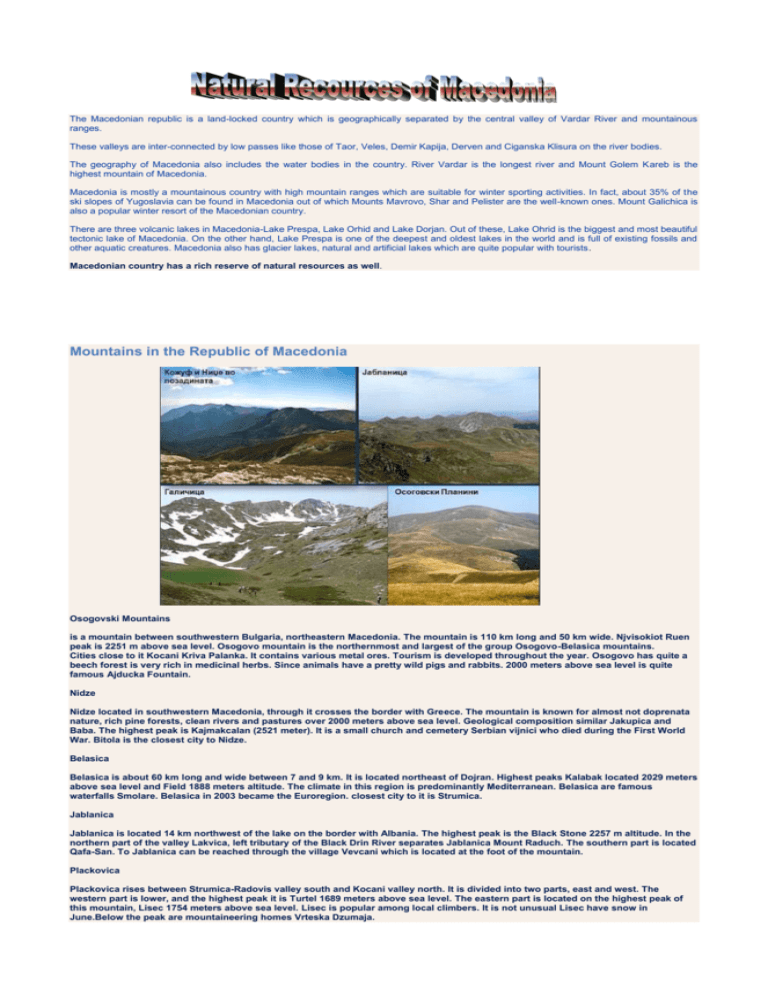Mountains in the Republic of Macedonia
advertisement

The Macedonian republic is a land-locked country which is geographically separated by the central valley of Vardar River and mountainous ranges. These valleys are inter-connected by low passes like those of Taor, Veles, Demir Kapija, Derven and Ciganska Klisura on the river bodies. The geography of Macedonia also includes the water bodies in the country. River Vardar is the longest river and Mount Golem Kareb is the highest mountain of Macedonia. Macedonia is mostly a mountainous country with high mountain ranges which are suitable for winter sporting activities. In fact, about 35% of the ski slopes of Yugoslavia can be found in Macedonia out of which Mounts Mavrovo, Shar and Pelister are the well-known ones. Mount Galichica is also a popular winter resort of the Macedonian country. There are three volcanic lakes in Macedonia-Lake Prespa, Lake Orhid and Lake Dorjan. Out of these, Lake Ohrid is the biggest and most beautiful tectonic lake of Macedonia. On the other hand, Lake Prespa is one of the deepest and oldest lakes in the world and is full of existing fossils and other aquatic creatures. Macedonia also has glacier lakes, natural and artificial lakes which are quite popular with tourists. Macedonian country has a rich reserve of natural resources as well. Mountains in the Republic of Macedonia Osogovski Mountains is a mountain between southwestern Bulgaria, northeastern Macedonia. The mountain is 110 km long and 50 km wide. Njvisokiot Ruen peak is 2251 m above sea level. Osogovo mountain is the northernmost and largest of the group Osogovo-Belasica mountains. Cities close to it Kocani Kriva Palanka. It contains various metal ores. Tourism is developed throughout the year. Osogovo has quite a beech forest is very rich in medicinal herbs. Since animals have a pretty wild pigs and rabbits. 2000 meters above sea level is quite famous Ajducka Fountain. Nidze Nidze located in southwestern Macedonia, through it crosses the border with Greece. The mountain is known for almost not doprenata nature, rich pine forests, clean rivers and pastures over 2000 meters above sea level. Geological composition similar Jakupica and Baba. The highest peak is Kajmakcalan (2521 meter). It is a small church and cemetery Serbian vijnici who died during the First World War. Bitola is the closest city to Nidze. Belasica Belasica is about 60 km long and wide between 7 and 9 km. It is located northeast of Dojran. Highest peaks Kalabak located 2029 meters above sea level and Field 1888 meters altitude. The climate in this region is predominantly Mediterranean. Belasica are famous waterfalls Smolare. Belasica in 2003 became the Euroregion. closest city to it is Strumica. Jablanica Jablanica is located 14 km northwest of the lake on the border with Albania. The highest peak is the Black Stone 2257 m altitude. In the northern part of the valley Lakvica, left tributary of the Black Drin River separates Jablanica Mount Raduch. The southern part is located Qafa-San. To Jablanica can be reached through the village Vevcani which is located at the foot of the mountain. Plackovica Plackovica rises between Strumica-Radovis valley south and Kocani valley north. It is divided into two parts, east and west. The western part is lower, and the highest peak it is Turtel 1689 meters above sea level. The eastern part is located on the highest peak of this mountain, Lisec 1754 meters above sea level. Lisec is popular among local climbers. It is not unusual Lisec have snow in June.Below the peak are mountaineering homes Vrteska Dzumaja. Babuna Babuna located northeast of Prilep, between north Pelagonija Veles Gorge. Kozjak highest peak is 1748 meters above sea level. Babu is among the intermediate high mountains. It has deep valleys so it has characteristic peaks. Babu has good pastures, so here is developed sheep. It is rich with mineral wealth (lead). In its base goes way Prilep-Veles. Deshat Deshat located on the border between Macedonia and Albania.Highest peak is Velivar 2375 meters above sea level. Other peaks that stand out are Small, Dry bar, etc.. It contains several small glacial lakes. Deshat is covered with forests. Closest city to it is Debar. In the eastern foot in the valley of the river Radika passes the Skopje-Debar. Stogovo Stogovo located in the western part of the Republic of Macedonia.The highest peaks are big hill 2278 feet above sea level and Babin Sickle 2242 meters above sea level. Here nature is almost intact because it near any population, and is visited often by climbers. . NATIONAL PARK PELISTER National Park Pelister is situated in the southwestern part of the Republic of Macedonia and covers an area of 12,500 hectares. It was proclaimed in 1948 as the first protected natural good in the country. Is characterized by a number of peaks and hills higher than 2000 meters, each separated by deep valleys. Pelister highest peak (2601 m).Of relief forms Pelister most so-called stone rivers. That relief inclinations filled with blocks of rocks of different composition. Hydrographic objects in their natural attractiveness two glacial lakes - Big and Small Lake Pelister, known as "Mountain Eyes". Pelister flora is very diverse, and therefore a specific botanical significance.Here grow 88 tree species, representing 29% of total dendroflora Macedonia. Pelister vegetation found 21 plant communities, 8 of which are forest and 13 herbaceous communities. Of forest tree species in the greatest value is Molika - indigenous species petoiglichest Pine tertiary age which grows only a few mountains in the Balkan Peninsula.Altitude of the molika distribution Pelister is from 600 to over 2200 meters. NP Pelister a classical find more than 20 plant species, of which 2 are local endemics. Vertebrates: 10 species of amphibians, 15 reptiles, 91 bird species and 35 mammal species. Of fish, it is important to emphasize the Pelister endemic trout (Salmo trutta peristericus) pelagonic trout (Salmo trutta pelagonicus). GALICICA National Park GALICICA National Park Due to the natural beauty and characteristic flora and fauna of the forests and forest areas Galicica, a larger part of it, an area of 22,750 hectares in 1958, has been declared a national park. Galicica National Park, situated in the southwest part of the Republic of Macedonia, is characteristic for its positioning between the two lakes, Ohrid and Prespa Lake, the involved orthography and interesting geomorphological forms (deep valleys, various types of karst forms and glacial relief forms).National Park Galichica particularly noted the abundance of floristic richness. The areas of a large number of plant species, representatives of various flora elements here, some of which reach the northern or southern limit of its distribution, or east or west. Finds of some of Galicica plant species are unique to the territory of the Republic of Macedonia. The territory of the park are 37 plant communities, 20 of which are forest. Galicica National Park is a classical find 20 species of higher plants (Cormophytae) of which 12 species are known only Galicica and Lake Ohrid and Lake Prespa and represent local endemics. Faunistic aspect area of national park Galichica registered 26 endemic species. Especially interesting is the number of butterflies - 1644 species, which is a huge concentration on such a small space. According to the numerical representation of the 30 species of amphibians and reptiles, Galicica National Park is approximately on the same level as it is the representation of the herpetofauna of the entire territory of certain central European countries (Germany, Switzerland, Austria and others.). Galicica class of birds is represented by 266 species, representing 84% of total Macedonian ornithofauna, while the mammals - 51 species, representing 62% of the total mammalian fauna in Macedonia. NacionalPark Mavrovo Nacional Park Mavrovo Mavrovo NP covers an area of 73,088 hectares and is the largest of the three national parks in Macedonia. It was proclaimed in 1948. The park covers: Korab, Deshat, southwestern parts of Sar Planina most Bistra the northern parts Krcin. The central part of the National Park valley and the confluence of the river Radika.The park brings together a number of interesting morphological forms: river valleys, gorges, waterfalls, karst fields, hollows, depressions, caves, cirques, glacial lakes, different types of denudation forms etc.. Most represented of the park's vegetation community of mountain beech forest. As a result of the great differentiation of relief, Mavrovo National Park is characterized by a remarkable floristic wealth, which consists of over 1000 species of higher plants, of which 38 tree species, 35 shrubs and about sixty endemic, relict and rare species. NP Mavrovo is a classical site for seven plant species, a unique find in Macedonia 12 rare plant species in the park's borders meet 33 other plant species that are very rare in other parts of Macedonia. The fauna of the National Park Mavrovo is rather diverse. It consists of 140 species of birds, of which the most significant are: the gray hawk, imperial eagle, Surrey (golden) eagle, forest owl, the great owl, pallid harrier, stepskata Harrier, and 11 amphibian species, 12 reptile species and 38 mammals. Among the mammals, the most important are: bear, lynx, chamois and wild cat. Natural Monument Lake Natural Monument Lake is located in the southwestern part of the Republic of Macedonia, at an altitude of 695 m, with an area of 358.2 km2, of which the Republic of Macedonia and belong to 229.9 km2. Ohrid valley, the bottom of which lies the lake, caused by tectonic patpred about 2 to 3 million years ago during the tertiary. With its 289 meters, Ohrid Lake is known as the deepest lake in the Balkan Peninsula. In the lake, due to geographic isolation and favorable hydrographic conditions, stored and it is home to more than 200 species of endemic organisms, ie 70% of the plants and animals in the lake with endemic character. A part of them are living fossils, almost unchanged since the tertiary period, such as the endemic sponge, relict snail species (over 27), of which 86% are endemic, several relict species worms, Ohrid Trout Belvica etc.. species of endemic nature, as well as a number of relict species of algae, including the diatoms are the most numerous. Many birds, some of which are CORINE species use the lake as a place for food and shelter during the winter. Because of this wealth of natural values, the lake in 1979 has been included in the World Heritage List as a natural right, and in 1980 due to the significant cultural and historical values in the wider area, it is nominarano and Ohrid natural and cultural-historical area.









